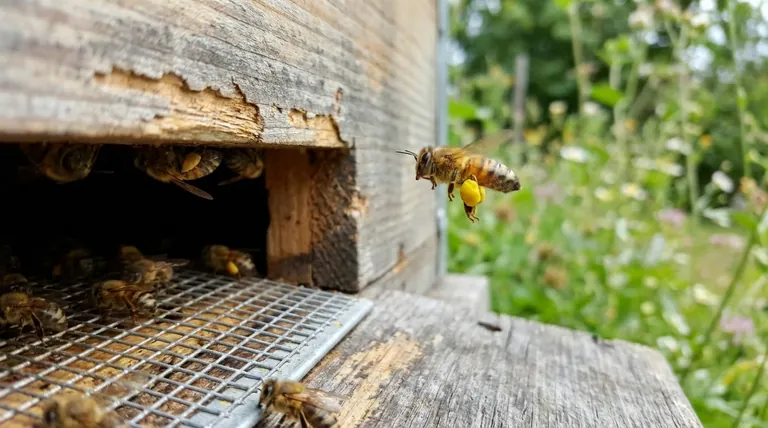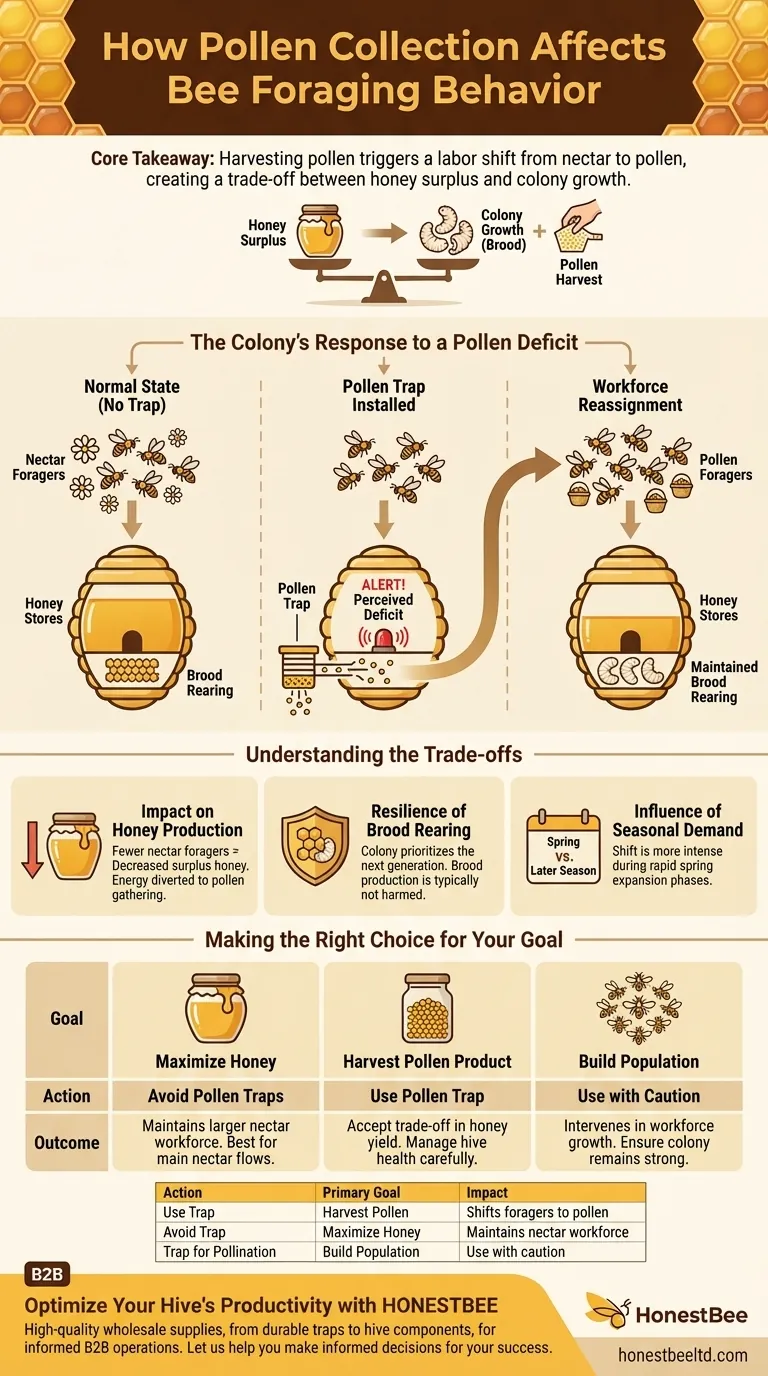Collecting pollen from a hive directly triggers a behavioral shift within the colony's foraging workforce. To compensate for the pollen being removed by a trap, the hive reassigns bees that were collecting nectar and tasks them with collecting pollen instead. This ensures the colony's brood-rearing needs are met, but it often comes at the cost of reduced honey production.
The core takeaway is that a honey bee colony is a self-regulating system that prioritizes its own survival. When a beekeeper harvests pollen, the colony adapts by shifting its labor force from nectar (energy storage) to pollen (brood rearing), revealing a direct trade-off between honey surplus and colony growth.

The Colony's Response to a Pollen Deficit
The Central Role of Pollen
Pollen is the colony's sole source of protein, fats, and minerals. It is absolutely essential for raising new bees, or brood.
As a colony expands its brood nest, particularly in the spring, its demand for pollen skyrockets to feed the developing larvae.
Detecting the Shortfall
When a beekeeper installs a pollen trap, it scrapes pollen pellets off the legs of incoming foragers. The bees inside the hive quickly perceive this reduction in available protein.
This perceived deficit acts as a powerful internal signal that the colony's food security, specifically for its young, is at risk.
Reassigning the Workforce
The colony's response is swift and efficient. It redirects a portion of its foraging force.
Bees that were specialized in collecting nectar are converted into pollen foragers. This remarkable flexibility allows the colony to immediately address the protein shortage and maintain its brood production.
Understanding the Trade-offs
The Impact on Honey Production
This behavioral adaptation has a direct and logical consequence: fewer bees are collecting nectar.
Because nectar is the raw ingredient for honey, reassigning these foragers almost always leads to a decrease in the amount of surplus honey the colony can produce. The energy that would have been stored as honey is instead spent gathering the missing pollen.
The Resilience of Brood Rearing
The colony's highest priority is the next generation. The conversion of foragers is a highly effective strategy to protect this priority.
Even with a pollen trap active, the colony's compensation mechanism is typically so effective that brood production is not harmed. The queen can continue laying eggs and the larvae will receive the nutrition they need to develop.
The Influence of Seasonal Demand
The intensity of this trade-off depends on the colony's needs. A hive in a massive spring expansion phase has a naturally high pollen demand.
Using a pollen trap during this period will trigger a more significant shift in foragers compared to using one later in the season when brood rearing may have slowed.
Making the Right Choice for Your Goal
Deciding to harvest pollen requires you to weigh your objectives against the colony's natural priorities.
- If your primary focus is maximum honey production: Avoid using pollen traps, especially during the main nectar flow, as it will divert the workforce needed to gather a large surplus.
- If your primary focus is harvesting pollen as a product: Accept that you are trading potential honey yield for pollen and manage the hive to ensure it remains strong and healthy.
- If your primary focus is building a large population for pollination: Use pollen traps with caution, as you are intervening in the very process that creates the strong workforce you require.
By understanding this fundamental behavioral trade-off, you can make an informed decision that aligns your beekeeping goals with the health of your colonies.
Summary Table:
| Action | Primary Goal | Impact on Foraging Behavior | Key Consideration |
|---|---|---|---|
| Use a Pollen Trap | Harvest Pollen | Shifts foragers from nectar to pollen collection | Accepts a trade-off in honey production |
| Avoid a Pollen Trap | Maximize Honey | Maintains a larger nectar-foraging workforce | Best during main nectar flows |
| Use Trap for Pollination | Build Population | Use with caution; can impact workforce growth | Ensure colony remains strong and healthy |
Optimize Your Hive's Productivity with HONESTBEE
Understanding the delicate balance between pollen and honey production is key to successful beekeeping. Whether you manage a commercial apiary or are a beekeeping equipment distributor, having the right supplies is crucial for supporting your hive's health and your harvest goals.
HONESTBEE supplies high-quality beekeeping supplies and equipment through wholesale-focused operations. From durable pollen traps to essential hive components, we provide the tools you need to manage your colonies effectively.
Let us help you make informed decisions for your operation. Contact our team today to discuss your specific needs and discover how our products can contribute to your success.
Visual Guide

Related Products
- HONESTBEE Advanced Ergonomic Stainless Steel Hive Tool for Beekeeping
- Professional Dual-End Stainless Steel Hive Tool for Beekeeping
- Professional 3-Bar Frame Grip with Integrated Hive Tool
- Full Set Beekeeping Electronic Bee Venom Collector Machine Device for Bee Venom Collecting
- Professional Galvanized Hive Strap with Secure Locking Buckle for Beekeeping
People Also Ask
- How is a hive tool used for scraping and cleaning? Master Hive Maintenance for a Healthy Colony
- What is a hive tool and what are its uses? Master Your Hive Inspections with the Essential Beekeeper's Tool
- Why is it important to compare the progress of different hives? A Beekeeper's Key Diagnostic Tool
- What are some common uses of a hive tool? Essential Multi-Purpose Tool for Every Beekeeper
- How should beekeepers handle bees when using a hive tool? Master Calm, Deliberate Techniques



















